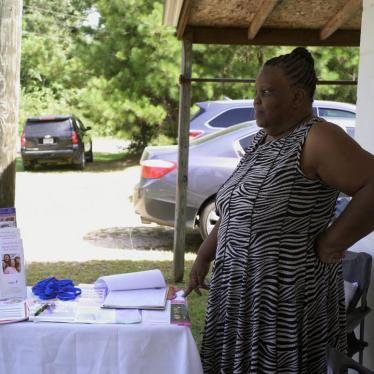“If I didn’t have to go to the doctor, I didn’t go,” a 47-year-old breast cancer survivor living in Greene County, Alabama, told my colleague last year about losing her insurance in 2012 when she was laid off from her job. She needs access to routine care, but unless it was an emergency, she avoided the health care system.
And she isn’t alone. Approximately 28 million people in the US are uninsured. In 2017 and 2018, Human Rights Watch documented what it looks like when women lack insurance and face other barriers to health care in parts of Alabama—and how those obstacles contribute to high rates of preventable deaths from cervical cancer.
No woman should die of cervical cancer, a highly preventable and treatable disease. Yet approximately 4,200 women die each year in the US from cervical cancer, and Black women are more likely to die from the disease than any other racial or ethnic group. Black women are more than one and a half times as likely to die from cervical cancer as white women in the US, and in Alabama—which has the highest rates of cervical cancer mortality of any US state—it’s almost twice as likely.
Alabama needs to do more to address the high death rates for women, particularly Black women, from cervical cancer in the state. It has one of the lowest Medicaid eligibility levels in the nation yet has not expanded Medicaid—which would bring in federal dollars to ensure that more low-income women have access to health care.
This isn’t just a public health concern—our research found that patterns of racial disparity, inequality, and exclusion all contribute to an environment in which Black women are less likely to receive the reproductive health care services and follow up care that they need to prevent and treat cervical cancer.
Many of the women we met with cited lack of consistent health insurance coverage as a significant barrier to treatment and care. Without consistent and reliable health insurance, many low-income women were forced to postpone or forgo treatment, including routine pap smears and follow up screening for abnormal results. Early detection matters, and gaps in coverage can mean that warning signs, which could detect and prevent cervical cancer before the disease progressed, are missed.
It’s hard for people living in cities to imagine—just being seen by a gynecologist can be an insurmountable challenge for women in Alabama. Fewer than half of the counties in Alabama, and only 4 of the 17 counties in the Black Belt—a predominantly rural region known for its primarily African American population and high rates of poverty—have a practicing gynecologist. Without access to public transportation, and having to travel long distances, women are sometimes forced to skip appointments because they can’t afford to get there. For some women we spoke to it meant tough decisions—like choosing between traveling to see a doctor and basic necessities, such as electricity or other medication.
People can’t prevent something they don’t know about or understand, and our research in Alabama showed that lack of access to information on cervical cancer is part of the problem. Alabama is one of 26 states that does not mandate comprehensive sexual health education in schools. It is missing an important opportunity to lay the groundwork for cancer prevention, among other health benefits. Comprehensive sexual health education can help educate students about these risks, including how to prevent HPV—human papillomavirus, the most common sexually transmitted infection—and the need for regular screening. Even if schools do want to provide this information, many are underfunded and don’t have the resources for sexual health education.
Alabama should make sure that its schools can provide young people with the information they need to prevent HPV and to lower their risk of cervical cancer. Communities should also have access to that information through community health workers, who can connect women to care and combat distrust in the health care system.
April is National Minority Health Month, dedicated to advancing health equity and raising awareness of health disparities affecting minorities in the US. Racial disparities in cervical cancer mortality rates in Alabama are just one glaring example of a lack of health equity in our country—but it seems particularly egregious considering we have the tools to prevent, detect, and treat cervical cancer.
In a country as wealthy as the US, it’s incomprehensible that such massive health disparities exist. Lawmakers in Alabama need to address how racial discrimination, inequality, and poverty significantly undermine the health of Black women in the state and to reduce the risk that women will die from a disease that no one should die from.









